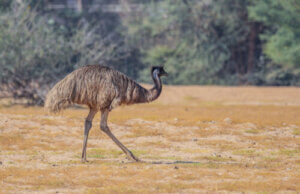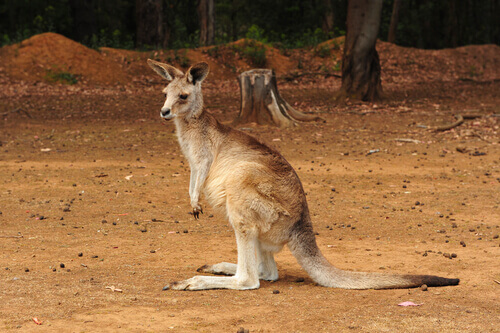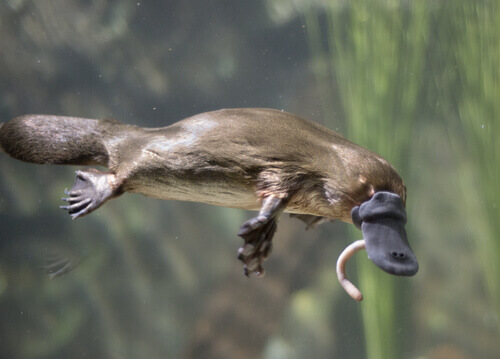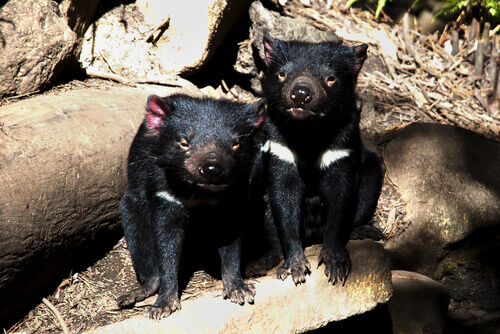5 Endemic Animals of Australia

Australia has some of the most amazing and unique species on the entire planet. In fact, the biodiversity of this country is unparalleled. Below, you’ll discover five endemic animals of Australia!
Why does Australia have so many endemic animals?
Australia is a unique territory. Many factors could explain the diverse and unique fauna that inhabits it. In fact, almost 85% of the mammals or 90% of the reptiles of this country are endemic. In other words, they don’t inhabit any other country in the world.
For starters, Australia occupies a very big territory that, because it’s an island, has been divided from the other continents for many thousands of years. Thus, the animals and plants that live there have reproduced and evolved without mixing with those of other places. But neither have new animals entered nor existing ones migrated.
On the other hand, Australia is a place with very little geological activity. No major catastrophes, such as earthquakes or volcanic eruptions, that destroy or kill thousands of animals in a short period of time, have occurred there. As it’s a calm place, life in Australia has been able to proliferate and has left us with a few very peculiar animals.
1. The emu
The emu, featured on the main image of this article, is the second biggest bird on the planet, only behind the ostrich. It’s one of the endemic animals of Australia. Although experts discovered three emu species, two of them are now extinct and only the common emu survives. It only inhabits the southern part of the island and Tasmania.
This animal is a peculiar bird that can’t fly. It’s brownish gray, in varying shades, and has a characteristic blue throat. The eggs it lays are dark green, very different from the eggs of other birds.
2. The kangaroo
The kangaroo is one of the best known endemic animals of Australia. Of all its species, the biggest is the red kangaroo: the males are over five feet long and weigh more than 187 pounds. This animal is famous for its two big, powerful hind legs and its long and muscular tail, which help it maintain its balance.

The kangaroo is a marsupial, meaning it’s a mammal that doesn’t spend much time in the uterus as a fetus, as it finishes developing in the female’s pouch. Although all kangaroos are herbivores, their specific diet depends on the areas of the country where they live and the plants available to them.
3. The koala
Other well-known marsupials are koalas. These endemic animals of Australia are much smaller than kangaroos. They’re less than three feet long and weigh between 17 and 33 pounds. The koala doesn’t have a tail and is characterized by its expressive head: big and round, with hairy ears.

This animal only feeds on eucalyptus leaves, which provide it with very little energy and nutrients. This is why the koala leads a very inactive life and can sleep up to 20 hours a day. This is a very asocial animal that doesn’t live in groups. Its habitat is limited to the westernmost part of the island.
4. The platypus
When European explorers returned from their first trip to Australia, and one of the biologists told their companions what a platypus was, they thought it was a joke. Even though it wasn’t, the platypus is indeed one of the strangest animals we know of.

It’s a mammal that lays eggs – there are only five known species that do so. It has a hairy body, a beak, and webbed feet, like a duck. It has a tail like a beaver’s and, in addition, it leads the life of an amphibian: it lives both in water and on land.
The male platypus is also venomous, as it has spurs on its hind legs. Although these spurs cause humans a lot of pain, they’re lethal for small mammals.
5. The Tasmanian devil
The Tasmanian devil wasn’t a cartoon invention. It’s a real animal! It’s the size of a small dog and weighs between 13 and 17 pounds. This animal has very short legs and a long tail that can be half the length of its entire body.

This animal is black with white spots. Although it’s quite competitive with specimens of its own species, it isn’t territorial. Instead of being a predator, this animal is actually an opportunist. If it finds carrion, it prefers to take advantage of it to hunt new prey.
Many endemic animals of Australia have curious or unique characteristics. Not only have mammals or birds evolved without the interference caused by migrations, but even Australia’s insects and fish are very different from those on the rest of the planet.
Australia has some of the most amazing and unique species on the entire planet. In fact, the biodiversity of this country is unparalleled. Below, you’ll discover five endemic animals of Australia!
Why does Australia have so many endemic animals?
Australia is a unique territory. Many factors could explain the diverse and unique fauna that inhabits it. In fact, almost 85% of the mammals or 90% of the reptiles of this country are endemic. In other words, they don’t inhabit any other country in the world.
For starters, Australia occupies a very big territory that, because it’s an island, has been divided from the other continents for many thousands of years. Thus, the animals and plants that live there have reproduced and evolved without mixing with those of other places. But neither have new animals entered nor existing ones migrated.
On the other hand, Australia is a place with very little geological activity. No major catastrophes, such as earthquakes or volcanic eruptions, that destroy or kill thousands of animals in a short period of time, have occurred there. As it’s a calm place, life in Australia has been able to proliferate and has left us with a few very peculiar animals.
1. The emu
The emu, featured on the main image of this article, is the second biggest bird on the planet, only behind the ostrich. It’s one of the endemic animals of Australia. Although experts discovered three emu species, two of them are now extinct and only the common emu survives. It only inhabits the southern part of the island and Tasmania.
This animal is a peculiar bird that can’t fly. It’s brownish gray, in varying shades, and has a characteristic blue throat. The eggs it lays are dark green, very different from the eggs of other birds.
2. The kangaroo
The kangaroo is one of the best known endemic animals of Australia. Of all its species, the biggest is the red kangaroo: the males are over five feet long and weigh more than 187 pounds. This animal is famous for its two big, powerful hind legs and its long and muscular tail, which help it maintain its balance.

The kangaroo is a marsupial, meaning it’s a mammal that doesn’t spend much time in the uterus as a fetus, as it finishes developing in the female’s pouch. Although all kangaroos are herbivores, their specific diet depends on the areas of the country where they live and the plants available to them.
3. The koala
Other well-known marsupials are koalas. These endemic animals of Australia are much smaller than kangaroos. They’re less than three feet long and weigh between 17 and 33 pounds. The koala doesn’t have a tail and is characterized by its expressive head: big and round, with hairy ears.

This animal only feeds on eucalyptus leaves, which provide it with very little energy and nutrients. This is why the koala leads a very inactive life and can sleep up to 20 hours a day. This is a very asocial animal that doesn’t live in groups. Its habitat is limited to the westernmost part of the island.
4. The platypus
When European explorers returned from their first trip to Australia, and one of the biologists told their companions what a platypus was, they thought it was a joke. Even though it wasn’t, the platypus is indeed one of the strangest animals we know of.

It’s a mammal that lays eggs – there are only five known species that do so. It has a hairy body, a beak, and webbed feet, like a duck. It has a tail like a beaver’s and, in addition, it leads the life of an amphibian: it lives both in water and on land.
The male platypus is also venomous, as it has spurs on its hind legs. Although these spurs cause humans a lot of pain, they’re lethal for small mammals.
5. The Tasmanian devil
The Tasmanian devil wasn’t a cartoon invention. It’s a real animal! It’s the size of a small dog and weighs between 13 and 17 pounds. This animal has very short legs and a long tail that can be half the length of its entire body.

This animal is black with white spots. Although it’s quite competitive with specimens of its own species, it isn’t territorial. Instead of being a predator, this animal is actually an opportunist. If it finds carrion, it prefers to take advantage of it to hunt new prey.
Many endemic animals of Australia have curious or unique characteristics. Not only have mammals or birds evolved without the interference caused by migrations, but even Australia’s insects and fish are very different from those on the rest of the planet.
This text is provided for informational purposes only and does not replace consultation with a professional. If in doubt, consult your specialist.








